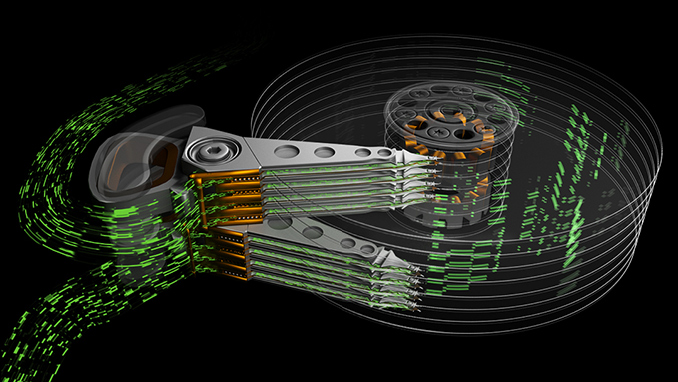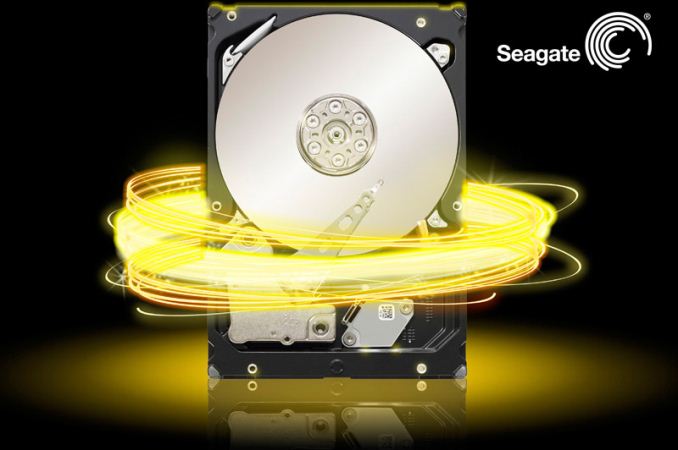Seagate’s Multi Actuator Technology to Address HDD IOPS Woes
by Anton Shilov on December 29, 2017 12:01 PM EST
Seagate introduced its new Multi-Actuator Technology (MAT) for hard drives earlier this month. It promises to increase hard drive performance by using two or more sets of actuator arms that operate independently from a single pivot point. Seagate claims that next-gen HDDs will require higher performance to effectively take advantage of their increased capacities. It plans to use MAT in their datacenter hard drives going into pilot production in 2018.
To improve the performance of next-generation hard drives, Seagate proposes to install not one, but two (or more) sets of actuators into a single HDD. The actuators are to be equipped with their own arms/heads as well as magnets to position them, but will use one pivot. As a result, the actuators will be able to act completely independently, essentially creating parallelism within a single hard drive. With an architecture like this, IOPS performance will scale with the number of actuators. Aggregate read/write performance of hard drives will also increase, but since it will depend on many factors, it is too early to make predictions regarding throughput of next-gen HDDs. The additional components required for two independent actuator assemblies (and a considerably more sophisticated HDD controller) will make such hard drives more expensive to build when compared to today’s models. This could be one of the reasons why Seagate plans to use its Multi-Actuator Technology only for hard drives designed for datacentres, where hardware costs are not as crucial as performance and features.
The first-generation MAT-enabled HDDs are to use two actuators operating on a single pivot point (along with 8 platters and 16 heads), but going forward the number of actuators may grow. Seagate says that the host computer can “treat a single Dual Actuator drive as if it were two separate drives”, but stresses that logically the HDD will remain a single device with two access streams for communication, just like dual-port SAS drives do. Meanwhile, Dual Actuator HDDs will be able to use not only SAS, but also NVMe and SATA interfaces. In the best-case scenario, a hard drive with two actuators can double the random read/write performance and almost double the sequential read/write performance compared to today's hard drives. The sequential access case is a bit tricky, since the cylinder height gets halved with two actuators, and a lot depends on how the addresses are translated to the actual physical sectors.
The arrival of new magnetic recording technologies in the coming years will significantly increase capacities of hard drives for cloud/exascale datacenters to over 20 TB by 2020 and to 40 TB within the next five or seven years. The upcoming HDDs will increase their sequential read/write performance along with the increase of their areal densities, but when it comes to latencies and random read and write operations, things get more complicated. The current HDD architecture uses a single actuator that synchronously moves all the arms with read-write heads over the media together for reading and writing data. With such an architecture, the platters can only work on one request at a time. Meanwhile, the more data an HDD stores, the more requests it gets and the more time it spends seeking the right track/sector. If/when fulfilling a request takes too long, quality of service (a metric dear to datacenter operators) suffers. Today, the performance bottleneck is solved by using either NAND flash or multiple hard drives in parallel, effectively combining their performance for certain access traces. At some point, this approach may become inefficient due to power/complexity and other factors. Therefore, it is imperative that HDDs get faster in order to cope with tomorrow’s workloads.
Seagate says that the Multi-Actuator Technology is to be deployed on products in the near future, but does not disclose when exactly. As the company’s blog post on the matter mentions both MAT and HAMR, it is highly likely that commercial hard drives featuring HAMR due in late 2019 will also have two actuators on a single pivot. At the same time, it does not mean that the MAT is not going to find itself a place in products using conventional PMR.
Related Reading
- Western Digital Stuns Storage Industry with MAMR Breakthrough for Next-Gen HDDs
- Toshiba Announces 14 TB PMR MG07ACA HDD: 9 Platters, Helium-Filled, 260 MB/s
- Toshiba Commercializes SDK’s 9th Gen PMR, Tech Enables 14 TB PMR HDDs in 2018
- Western Digital Now Shipping 14 TB HDDs: HGST Ultrastar Hs14 with 1000 Gb/in2
- Western Digital Announces Ultrastar He12 12 TB and 14 TB HDDs
- Seagate Announces Enterprise Capacity 12 TB HDD: 2nd-Gen Helium-Filled Hard Drives
Source: Seagate











88 Comments
View All Comments
eek2121 - Friday, December 29, 2017 - link
I was wondering when a company was going to step up and do this. They should also have a second set of actuators on the opposite side of the platter. They could boost performance to the point where hard drives become competitive with SSDs. If they could get performance up to the level of a SATA SSD, many people would be willing to pay the premium. a 4TB drive that performs like an SSD for $250? I'll take 4.Also, from the sound of things it seems like these drives will be relying on RAID for the performance increase? They should handle this stuff in the drive controller.
quiksilvr - Friday, December 29, 2017 - link
All the actuators in the world will never beat the speed of light. This is great for NAS or hosting VMs but this will not replace SSDs.sor - Friday, December 29, 2017 - link
You’re right, but I think the theory was that with multiple actuators you could get into the ballpark of SSDs on a IOPs number. Latency will still be close to the same, but you could realistically get a spinning disk up to low 1000s of Random IOPs with multiple actuators, not far off from the 2k-8k IOPs a busy Samsung 840 Pro SSD will do.ImSpartacus - Friday, December 29, 2017 - link
So you're saying it's no longer orders of magnitude apart?saratoga4 - Friday, December 29, 2017 - link
> you could realistically get a spinning disk up to low 1000s of Random IOPs with multiple actuators,If the HDD read speed were infinitely fast, a 5 ms seek time means 200 IOPS per actuator. Getting to even 1000 IOPS would require an insanely fast read speed and 5 actuators, which doesn't seem too likely.
>not far off from the 2k-8k IOPs a busy Samsung 840 Pro SSD will do.
The 840 Pro can hit 20k IOPS for random IO. You would need more than 100 platters + actuators to match that.
sor - Friday, December 29, 2017 - link
Responding to OP’s idea of multiple actuators, given that a single HDD today is good for up to 150 IOPs, we could assume about 150 per actuator. Taking the idea to a logical advancement of say 8 distinct actuators (maybe two pivots on opposite sides of the platter with four distinct heads each) you’d get over 1k IOPs.I’m not saying this will ever happen, and there are details like having to be seeking evenly across all platters to get top speed, but there’s potential there. If you’d have asked me if we would see this MAT tech at all I would have been skeptical.
Bullwinkle-J-Moose - Friday, December 29, 2017 - link
"but you could realistically get a spinning disk up to low 1000s of Random IOPs with multiple actuators, not far off from the 2k-8k IOPs a busy Samsung 840 Pro SSD will do."----------------------------------------------------------------------------------------------------------
An 850 Pro will copy and paste data from and to itself at twice the speed of an 840 Pro
Internal throughput on SSD's has been ignored at this site ever since I first brought it up over a year ago
Try improving on the best case scenario / not the worst!
Synthetic tests have no place in the real world
Billy and Ryan need to wake up and smell the cofee
jordanclock - Friday, December 29, 2017 - link
Why do we care about how fast an SSD copies data on itself? Is this really a bottleneck for any common use cases?WinterCharm - Friday, December 29, 2017 - link
Many tasks like video editing require this sort of thing. So there's a significant amount of stuff that uses this type of processing.jordanclock - Saturday, December 30, 2017 - link
That sounds like an atypical use case to me. But yes, that would absolutely be a scenario where you would want high copy speeds on the same drive.